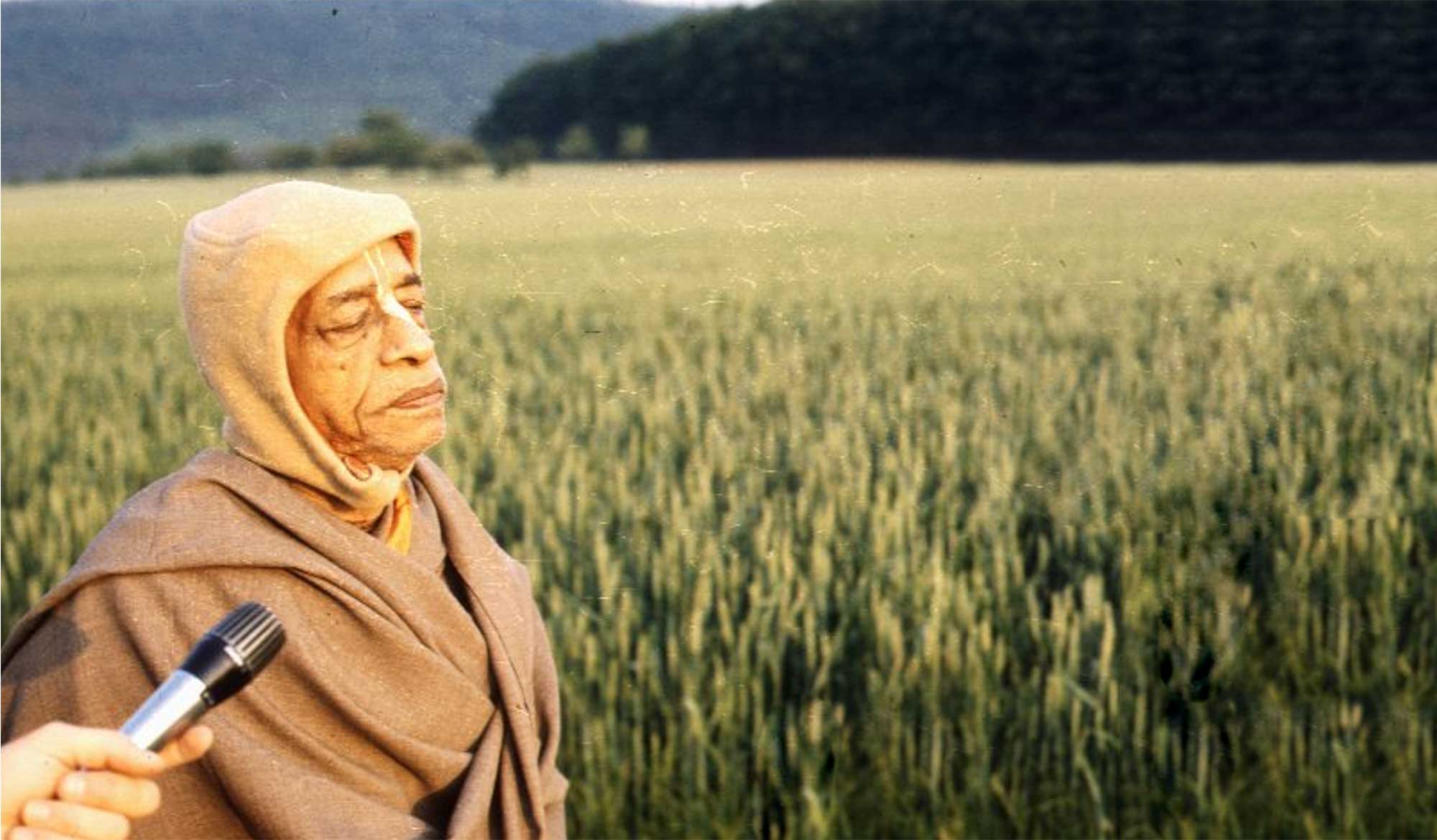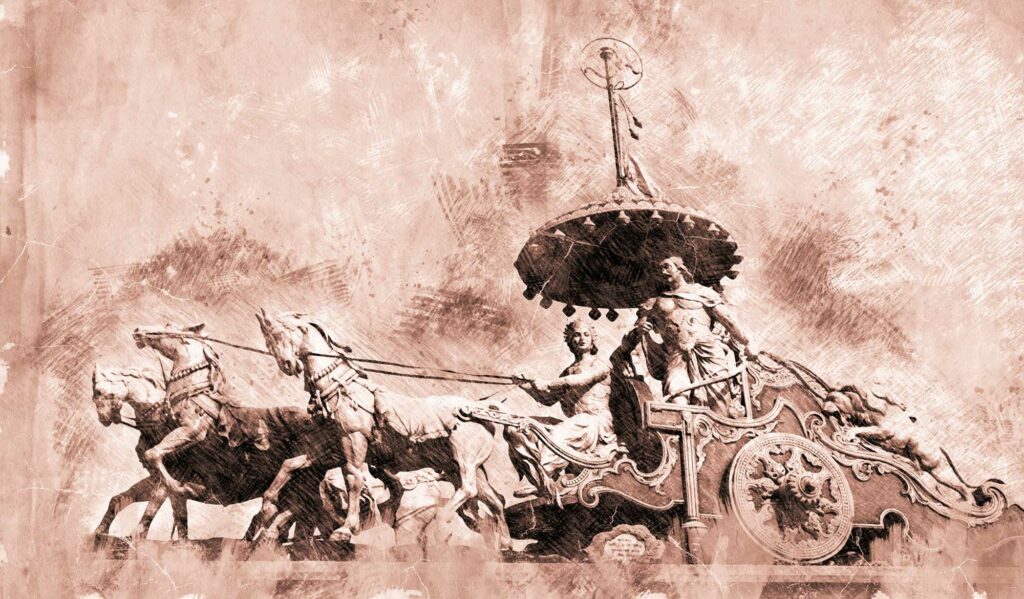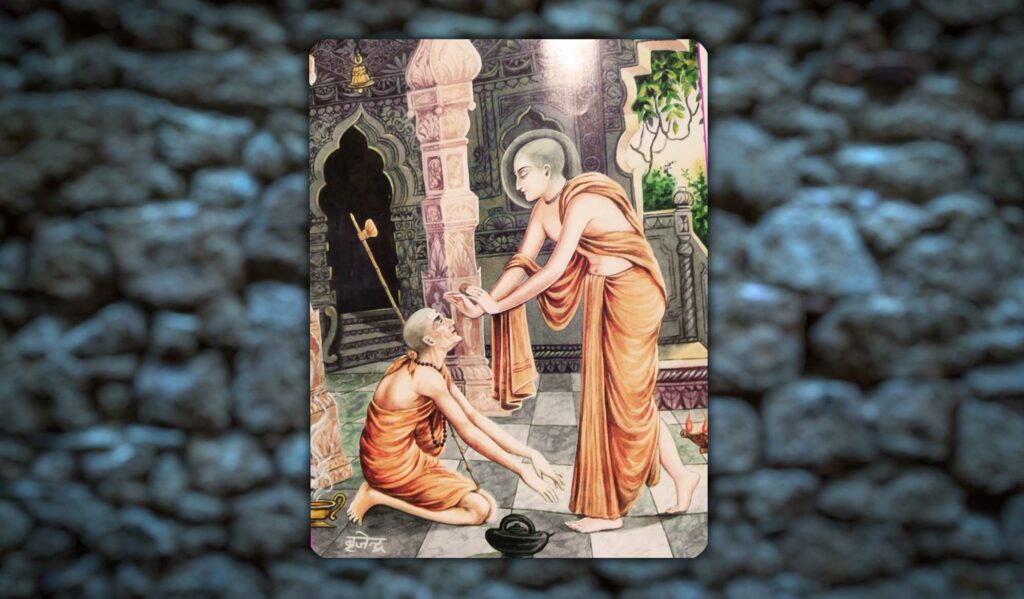Overview
This short article, “Grow More Food” by Śrīla A.C. Bhaktivedānta Swami Prabhupāda was first published in Back To Godhead magazine, Vol. 3, Issue 6, on May 20th 1956. Śrila Prabhupāda discusses agricultural endeavours by the materialists and states that the main factor for growing more food is not more machinery, but the divine will, or ‘daiva.’
“Many countries have invested quite heavily in plans to bring back into use land abandoned for hundreds of years, or land that has never been used at all. They have brought all kinds of heavy earth moving tractors and machines for land development and introduced new forms of power into their agriculture. In many cases tractors, machines and implements have been brought in without taking into account the position of the cultivator, of the man who works on the land and who must ultimately make these things pay. And frequently they have been purchased before sufficient training and maintenance facilities were available. Of course, there are also exceptions and some land development and mechanisation projects have proved successful from their inception.”
The above is a quotation from the UNESCO Food and Agriculture organisation. The enthusiasm for tractors over other implements has not always proved successful and in many cases, as we have personal experience of some places in U.P., it has often meant false starts on schemes that on paper looked so promising and easy.
The transcendentalist however will not agree that only tractors and other agricultural implements can solve the problem of growing more food and inadequate living standards. Besides the tractor and implements used by the man who will work on the land of cultivation, there is another supreme hand in the successful termination of the productive enthusiasm. This ultimate cause is called daiva, or the unseen power of God, inconceivable by the human brain. This power can ultimately make all things null and void and conquer over all other enthusiasm and abilities of the human being. In the Bhagavad-gītā we have this information as follows:
adhiṣṭhānaṁ tathā kartā karaṇaṁ ca pṛthag-vidham
vividhāś ca pṛthak ceṣṭā daivaṁ caivātra pañcamam
(Bhagavad-gītā 18.14)
To effect successful results in the attempt of agricultural enthusiasm there are five causes, namely the situation of the land, the man who works in the field, the instruments or implements applied in the enterprise, and above all, the hidden hand of natural forces known as daiva.
Whatever is attempted and done in this world, physically or mentally, by any man which may be right or wrong in the estimation of the public, must have all the abovementioned five causes behind the attempt. Nobody should therefore see only the visible causes for effective result, but must look into the invisible cause called the daiva.
Above all other causes, the daiva cause is the most powerful. This daiva cause, or the Supreme cause, is the ultimate control of physical nature which is the external energy of Godhead. The land, implements, the worker, the attempt – all depend on the ultimate cause called daiva. It is also known as prakṛti.
Everything is done by prakṛti, but egoistic fools think that the work is performed by them. In spite of good tilling of the land and the expert tiller, good tractors or other implements, and the most sincere and accurate plan of work ,it is quite possible that the whole attempt may be frustrated for want of sufficient rains. Without rains all other arrangements will stand null and void due to the reaction of the daiva cause. This daiva cause is made effectively favourable by the process of yajña described elsewhere in this issue.
Along with the creation of the prajas or the living beings, the yajñas or sacrifices on account of Viṣṇu the Supreme Being was also created. By the performance of yajñas, the controlling deities who supply us light, air, heat, water etc. which are all essential factors in the matter of the growing more food campaign, are satisfied. By their satisfaction only everything is produced nicely and sufficiently. When there is sufficient production by the mercy of daiva, the inadequate standard of living is mitigated. Otherwise every attempt becomes futile.
Related Articles & Books
Further Reading
- A Vaiṣṇava Householder’s Hospitality to Guests by Śrīla Bhaktivinoda Ṭhākura
- The Livelihood of Householder Vaiṣṇavas by Śrīla Bhaktivinoda Ṭhākura
- The Brāhmaṇa and the Vaiṣṇava – Both are Completely Vedic by Śrīla Bhaktivinoda Ṭhākura
- The Savings of a Vaiṣṇava by Śrīla Bhaktivinoda Ṭhākura
- Begging Alms by Śrīla Bhaktivinoda Ṭhākura
- Brāhmaṇism and Vaiṣṇavism by Śrīla Bhaktivinoda Ṭhākura
- The Marriage System of Bengal by Śrīla Bhaktivinoda Ṭhākura
Pilgrimage with Swami Narasiṅgha – Part 7: Keśī Ghāṭa
Continuing with our pilgrimage series, this week Śrīla Narasiṅgha Mahārāja takes us to Keśī Ghāṭā where he tells us about Madhumaṅgala’s meeting with the Keśī demon, what Keśī represents, and how Śrīla Prabhupāda almost acquired Keśī Ghāṭa. Mahārāja also narrates his own experience. This article has been adapted from a number of talks and articles by Narasiṅgha Mahārāja.
Prema Dhāma Deva Stotram with the Narasiṅgha Sevaka Commentary – Verses 61-65
In verses 61 to 65 of 'Prema Dhāma Deva Stotram', Śrīla Śrīdhara Mahārāja narrates the pastime of Śrī Caitanya at Caṭaka Parvata In Purī and explains how the scriptures produced by Brahmā and Śiva are ultimately searching for the personality of Mahāprabhu who is merciful too all jīvas, no matter what their social position.
Prabhupāda Śrīla Sarasvatī Ṭhākura’s Visit to Ayodhyā
With the forthcoming observance of Śrī Rāma Navamī, we present 'Prabhupāda Śrīla Sarasvatī Ṭhākura’s Visit to Ayodhyā' written by Śrīla Bhaktisiddhānta Sarasvatī Ṭhākura Prabhupāda from The Gaudīyā magazine, Vol 3. Issue 21/ In December 1924, after visiting Benares and Prāyāga, Sarasvatī Ṭhākura visited the birth-site of Śrī Rāmācandra in Ayodhyā.
Śaraṇāgati – The Only Path to Auspiciousness
In this article, 'Śaraṇāgati - The Only Path to Auspiciousness', Dhīra Lalitā Dāsī analyses the process of śaraṇāgati (surrender) beginning with śraddhā (faith). She also discusses the role of śāstra and the Vaiṣṇava in connection with surrender.
Pilgrimage with Swami Narasiṅgha – Part 7: Keśī Ghāṭa
Continuing with our pilgrimage series, this week Śrīla Narasiṅgha Mahārāja takes us to Keśī Ghāṭā where he tells us about Madhumaṅgala’s meeting with the Keśī demon, what Keśī represents, and how Śrīla Prabhupāda almost acquired Keśī Ghāṭa. Mahārāja also narrates his own experience. This article has been adapted from a number of talks and articles by Narasiṅgha Mahārāja.
Prema Dhāma Deva Stotram with the Narasiṅgha Sevaka Commentary – Verses 61-65
In verses 61 to 65 of 'Prema Dhāma Deva Stotram', Śrīla Śrīdhara Mahārāja narrates the pastime of Śrī Caitanya at Caṭaka Parvata In Purī and explains how the scriptures produced by Brahmā and Śiva are ultimately searching for the personality of Mahāprabhu who is merciful too all jīvas, no matter what their social position.
Prabhupāda Śrīla Sarasvatī Ṭhākura’s Visit to Ayodhyā
With the forthcoming observance of Śrī Rāma Navamī, we present 'Prabhupāda Śrīla Sarasvatī Ṭhākura’s Visit to Ayodhyā' written by Śrīla Bhaktisiddhānta Sarasvatī Ṭhākura Prabhupāda from The Gaudīyā magazine, Vol 3. Issue 21/ In December 1924, after visiting Benares and Prāyāga, Sarasvatī Ṭhākura visited the birth-site of Śrī Rāmācandra in Ayodhyā.
Śaraṇāgati – The Only Path to Auspiciousness
In this article, 'Śaraṇāgati - The Only Path to Auspiciousness', Dhīra Lalitā Dāsī analyses the process of śaraṇāgati (surrender) beginning with śraddhā (faith). She also discusses the role of śāstra and the Vaiṣṇava in connection with surrender.








